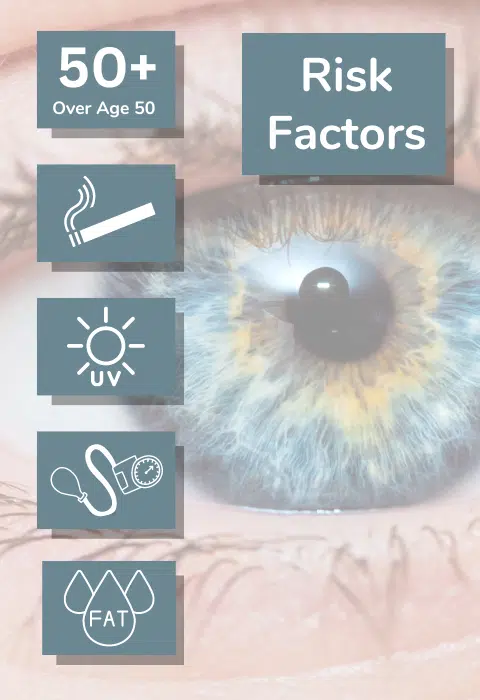What is Age-Related Macular Degeneration, and could it impact me?
Age-related macular degeneration, or AMD, is a disease in the back of the eye which impacts a person’s central vision. It is the most common cause of severe vision loss in people aged 50 or older. The effects of AMD range from mild blur or distortion of central vision to profound central vision loss. The prevalence of AMD increases significantly as we age. A census done in 2019 revealed that approximately 2% of Americans aged 40-44 were living with AMD, but that number rose to 46.6% for people who were 85 or older. Annual dilated eye exams are important for early diagnosis and management of the disease.

What are the Risk Factors for AMD?
The biggest risk factor for AMD is age, specifically anyone over the age of 50. Other risk factors include smoking, high blood pressure, a diet high in saturated fats and cumulative UV light exposure over the course of a person’s life. The most common symptoms of AMD are blurry vision, distorted or wavy central vision, difficulty recognizing faces or a dark blind spot in the center of vision. If you or anyone you know is over 50 and has developed any of these symptoms, contact your local eye care provider and schedule a dilated eye exam.
Are there different types of AMD?
There are two different forms of AMD: dry (nonexudative) and wet (exudative) macular degeneration. Although both can cause central vision loss, dry AMD is generally more common and less severe. In dry AMD the nerve tissue in the center of the retina slowly breaks down causing gradual central vision loss. Progression of dry AMD can convert to wet AMD. During wet AMD abnormal vessels begin to grow under the retina. Those vessels leak and hemorrhage, causing more damage to the macula. Wet AMD usually causes faster and more severe loss of central vision than dry AMD.

What can be done for AMD?
Prevention and early diagnosis are key factors in limiting vision loss from AMD. Protecting your eyes from harmful UV light, not smoking, and eating a diet higher in dark leafy green vegetables are ways to take an active approach in trying to prevent the start of AMD. The Eyecare Team at Lakeview Clinic includes Dr. Bradley Ludwig, Dr. Tracy Jackson and Dr. Thomas Bryan. They have many years of experience using retinal cameras and other forms of diagnostic imaging to diagnose and manage patients with age related macular degeneration. Once a patient is diagnosed it cannot be cured, so the goal of treatment is to prevent progression. Lifestyle modifications and vitamin therapy specifically formulated for dry AMD is the standard treatment. If the disease converts to wet AMD, referral to a retinal specialist is required for further treatment.

Dr. Thomas Bryan, O.D.
Dr. Thomas Bryan is an optometrist practicing eye care at Lakeview Clinic in Waconia, Minnesota. He enjoys all aspects of optometry, but especially medical cases and contact lens patients.
